Caspar Gomez stays offline at Glastonbury. This report arrived at theartsdesk two days later handwritten by fax with an accompanying preamble which said only, “This scribble has now suitably matured in the cider-oaked barrels of a pot-holed brain. I am Uncle Fuckle and I’m here to bring the pain. It began like this…”
Thursday 25th June
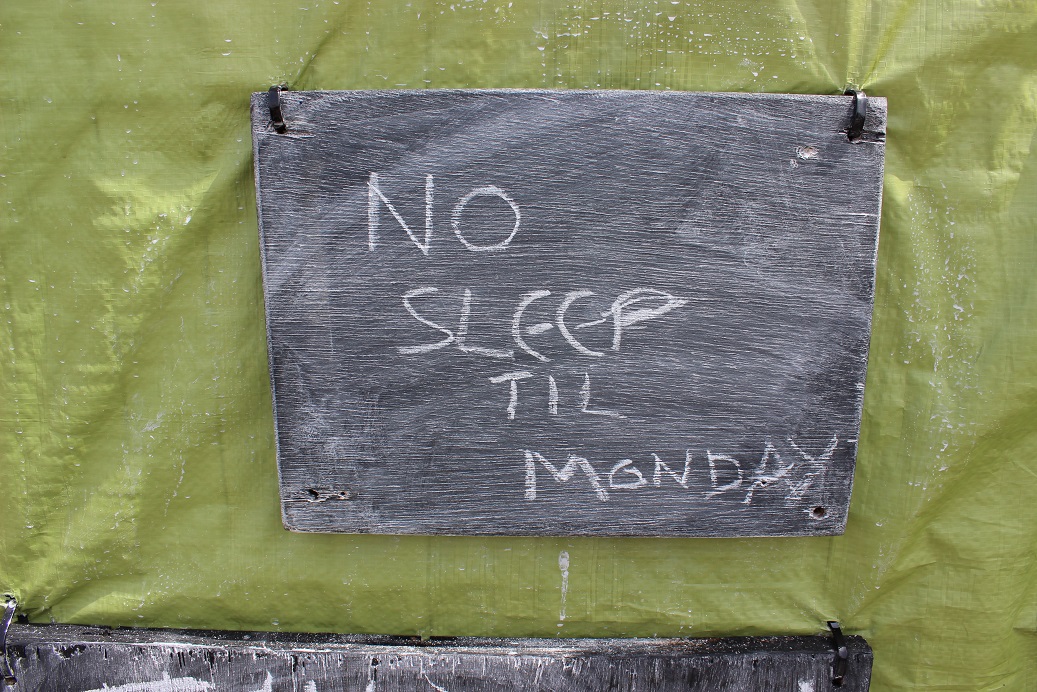
“I've been to a lot of festivals and I have to say that nothing beats watching them on telly,” comes the first response. “If necessary, put your flat screen in the back garden and invite a load of friends round.”
Ah, this is the stuff. The English and their fucking homes, their sofas, their coffee, Kevin McCloud, Jack Wills fleeces, gyms, Sir Alan Sugar, cute cats, Christian Grey, broadsheet features about good parenting, and endless debates about Jeremy fucking Clarkson. Presumably this same person prefers travel programmes to foreign holidays and a night in watching Come Dine With Me to a good restaurant. I can’t wait to leave. There’s another England and, laptop off by midday, I head for the train to find it.
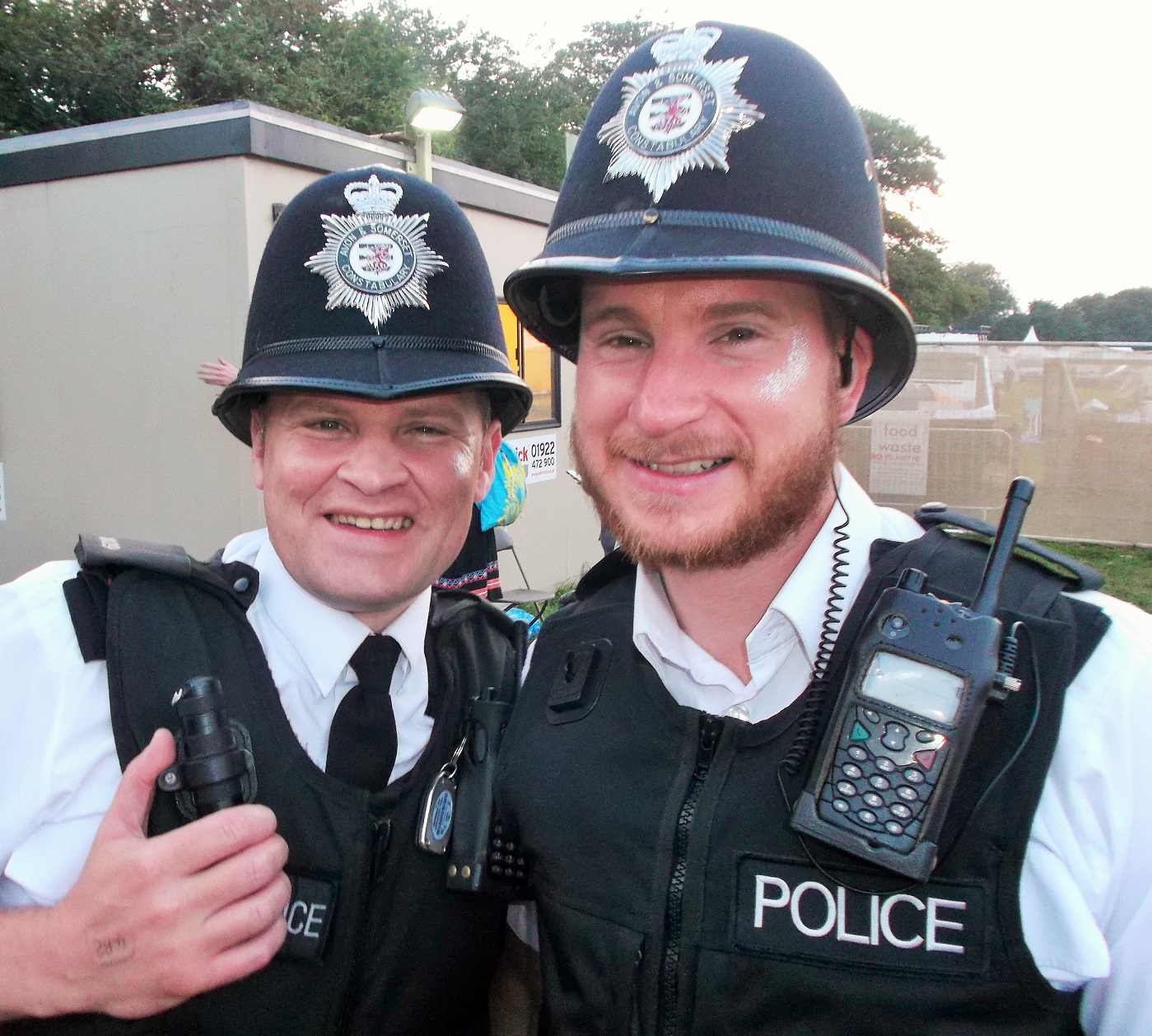
I travel light. My associate Finetime arrives tomorrow by car with the rest of the gear. I set up camp just north of the John Peel stage in Hospitality, with a 7% Suffolk cider now on the go, and almost immediately run into my friend, Glastonbury perennial Don Carlton, bearded, perspiring, and wearing a straw trilby that will remain glued to his head for the next four days. He’s putting up a much-too-large-for-two-people green tent while his cohort Kupe watches. Kupe doesn’t do tent-putting-up. Instead he’s in the process of rescuing two women, Leia and Fojan, 30-something mothers and Glastonbury virgins from Brighton. They have left their children behind and want to party. Unfortunately, they have also left their tent poles behind. They sit looking somewhere between jovial and forlorn amid a giant, deflated heap of blue canvas, surrounded by a thousand bags that contain everything a girl might need. Apart from tent poles. Don and Kupe offer them a space in their giant tent and we all hump their gear over.
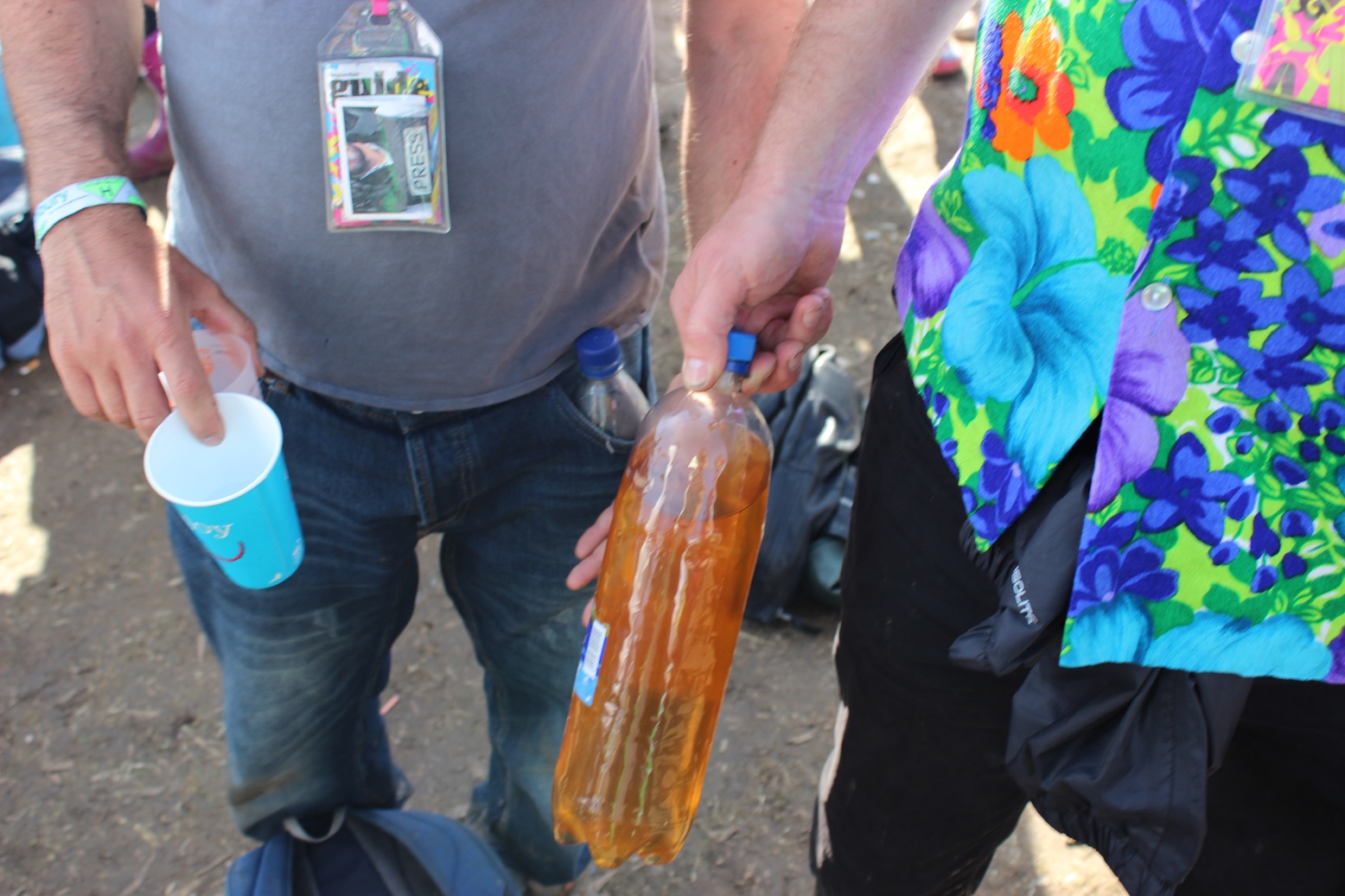
The rule of Thursday is to avoid getting munted. Or at least, not really push the boat out to annihilation. Four days is all there is of this, temporarily the second biggest city in Somerset after Bath, so maximising time awake and capable is vital.
After consuming a six-pack of small pork pies, a Morrisons crustless quiche and a chunky bump of Energizer Z, by way of supper, it’s time to visit the Somerset Cider Bus, the annual ritual of repeatedly refilling a two-litre water bottle with two-thirds dry to one-third medium scrumpy. It is the one true bio-petrol that keeps the body ticking. Placing a same-scaled map of the Glastonbury site over a familiar town or city – someone did it online with Brighton shortly before the festival – gives an idea of the energy involved in perpetually tramping its miles. Distances I’d never normally dream of constantly walking become the norm. Time for a wander, then.

Further on my Glastonbury rhythm starts to arrive. The feeling of shaking off the world outside and relaxing into the chaos, not worrying if I miss a band I want to see, not worrying about anything, just rolling wherever feels good. It hits as I move around in the crowd at Shangri-Hell, part of the Shangri-La fields, a red surrealist miniature Eastern Bloc-style city-state of anti-corporate poster art. Onstage a Mancunian collective called Slamboree, part band, part riotous circus, are hooping and flame-throwing and playing rabid gypsy polka one minute and booming drum & bass the next. It puts the jiggle into me, as does Energizer Z, served from the screwdriver of a Swiss Army knife, a key tool of festival nights. Don finds a small but stylish, brand new green plastic watering can on the ground amid the dancing crowd. Its label and maker's tag are still on. Why is it here? He brandishes it then ties it to his scarf. It must have disappeared later as I don’t recall ever seeing it again.

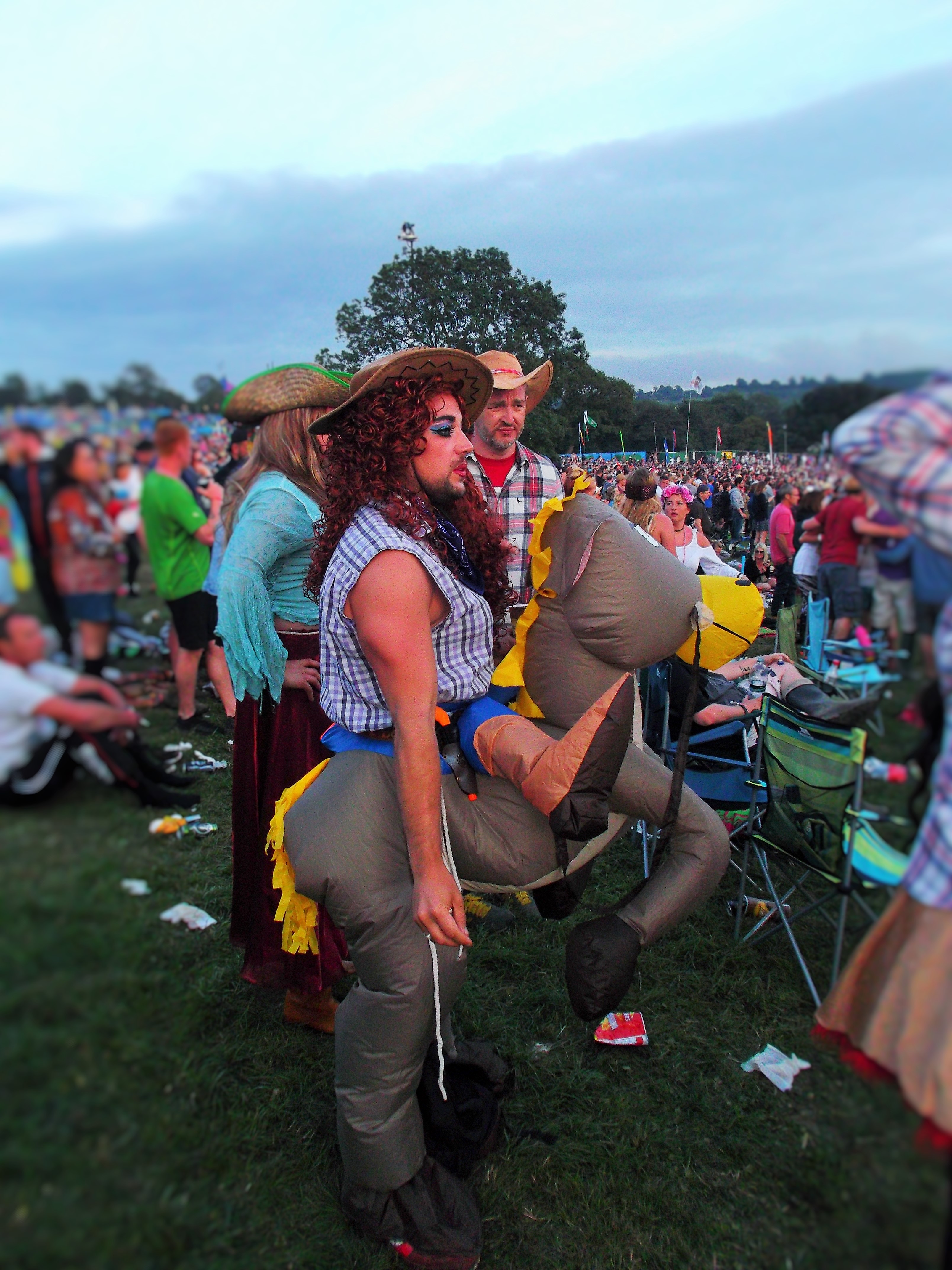
Don and Leia disappear to crash but Fojan, cheeky and fiery, wants to party. Unfortunately for her, I remain staunchly Ye Boring Grandad Preacher of Glastonbury’s Thursday Rules. I want to eat tomorrow all up, the festival’s true beginning, and won’t be distracted from my mission. In truth, I’m sidetracked enough for a quick puff and a tray of tasty Middle Eastern savouries from a stall, but not to the temptations of further narcs and multitudes of dark corners bangin’ out beats. Instead I fall asleep in my tent around 3.00 AM to the sound of the Silent Disco’s distant choir of acapella voices echoing across the valley, raising "Hey Jude" to the now star-speckled heavens.
Friday 25th June
Awake at 8.00 AM feeling not so good. This is earlier than I should be conscious, surely? Loud voices have done this. 8.00 AM is surely the one hour at festivals when no-one – outside the children’s and family fields – should be awake? The nightworld is crawling into its hole and the dayworld has yet to rise. Why would you want to be awake now? The first acts are on at 11.00. This is just dead time. I soon find out. Plummy, giggly voices, male and female, are discussing caffè lattes and how they queued two hours for a shower but “how refreshing!” What ails these people? Can they not leave their rituals behind? They’re going to be knackered later. They’ll need back energy and hours spent queuing for a shower. And to what purpose? And caffè lattes? Where to begin? I recall at Glastonbury 1994 a friend-of-a-friend suggested we all get a coffee and everyone just laughed at him. That was in the days before the vile bean took over our high streets. There is little point protesting these misguided souls or my fuzzy head, so I laze in torpor until 10.30-ish, then, after a quick tap-wash and shave, head out.
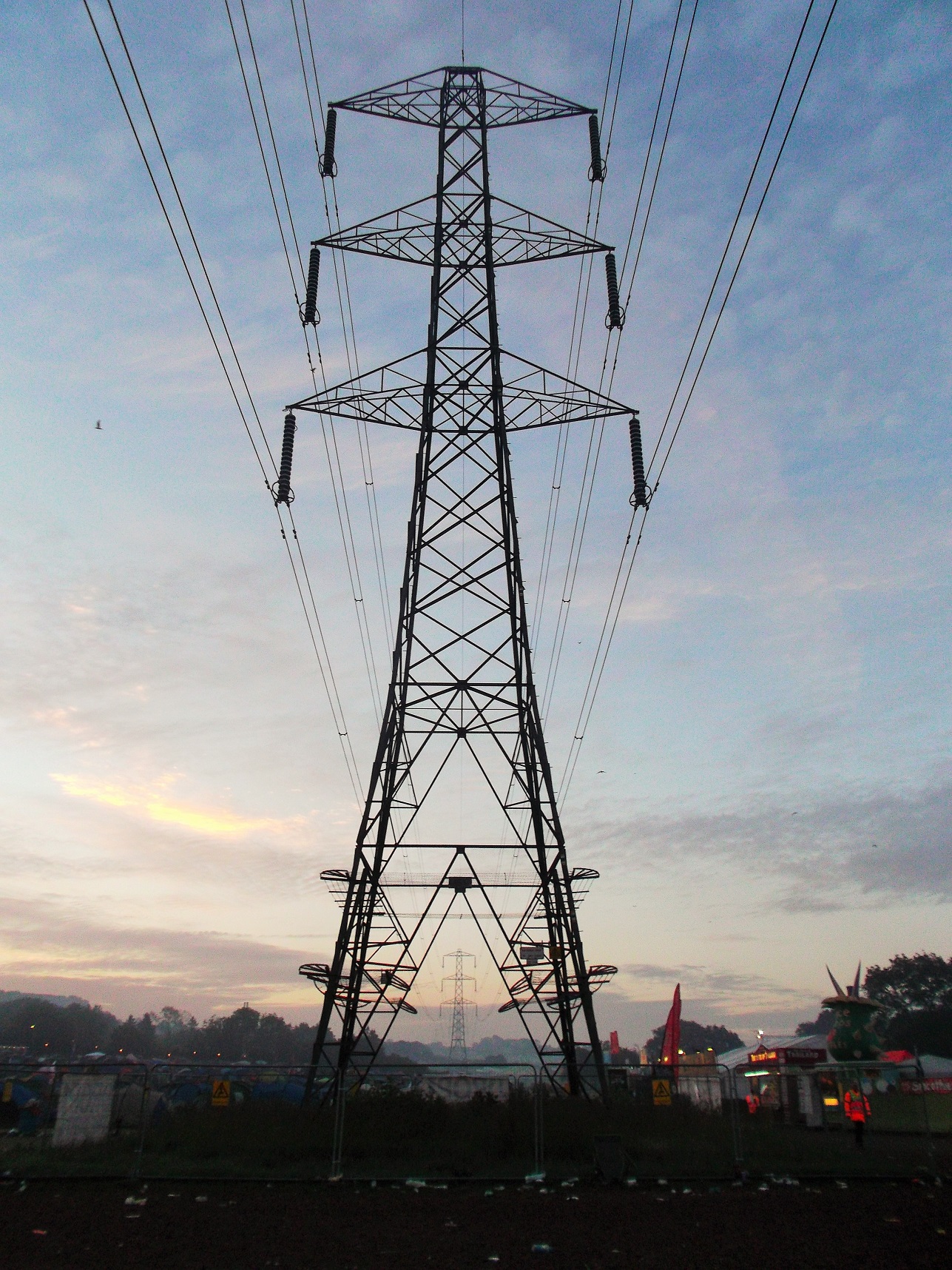

I find Dane and Bomber near a bar and lagers are ordered. Bomber has been abstaining from everything for months, Narcotics Anonymous, the lot. Eighteen minutes after getting into Glastonbury that all went out of the window. He is, he says, “hanging” this morning, but he tucks into a beer, nevertheless. It’s a four-day aberration. He sighs and gives in to it. This is a hard place for sobriety, even for those who maybe should. Bomber will be back to his regimen on Monday. No pointing in beating yourself up. Glastonbury comes but once a year.
We arrive at The Glade, a tree-shaded corner overseen by camouflage netting and cubic LED light installations, in time for The Egg. They’re a venerable festival jam band, responsible for one of the 1990s forgotten gems, their Albumen debut. It’s two decades since but they’ve re-expanded from the core unit of twins Ned and Maff Scott to a four-piece. On stage with them a coil-haired woman paints at an easel. She’s there all day, like at a Sixties happening, detailing an image that appears to be an angel flying over pyramids into the sun. Beside her The Egg’s liquid grooves are ingrained with sweet melody – always what set them apart from most stoner bands of their ilk. It’s like early house music hijacked by the BBC Radiophonic Workshop or, on “Electric City”, Kraftwerk, with occasional attacks of funk rock guitar.
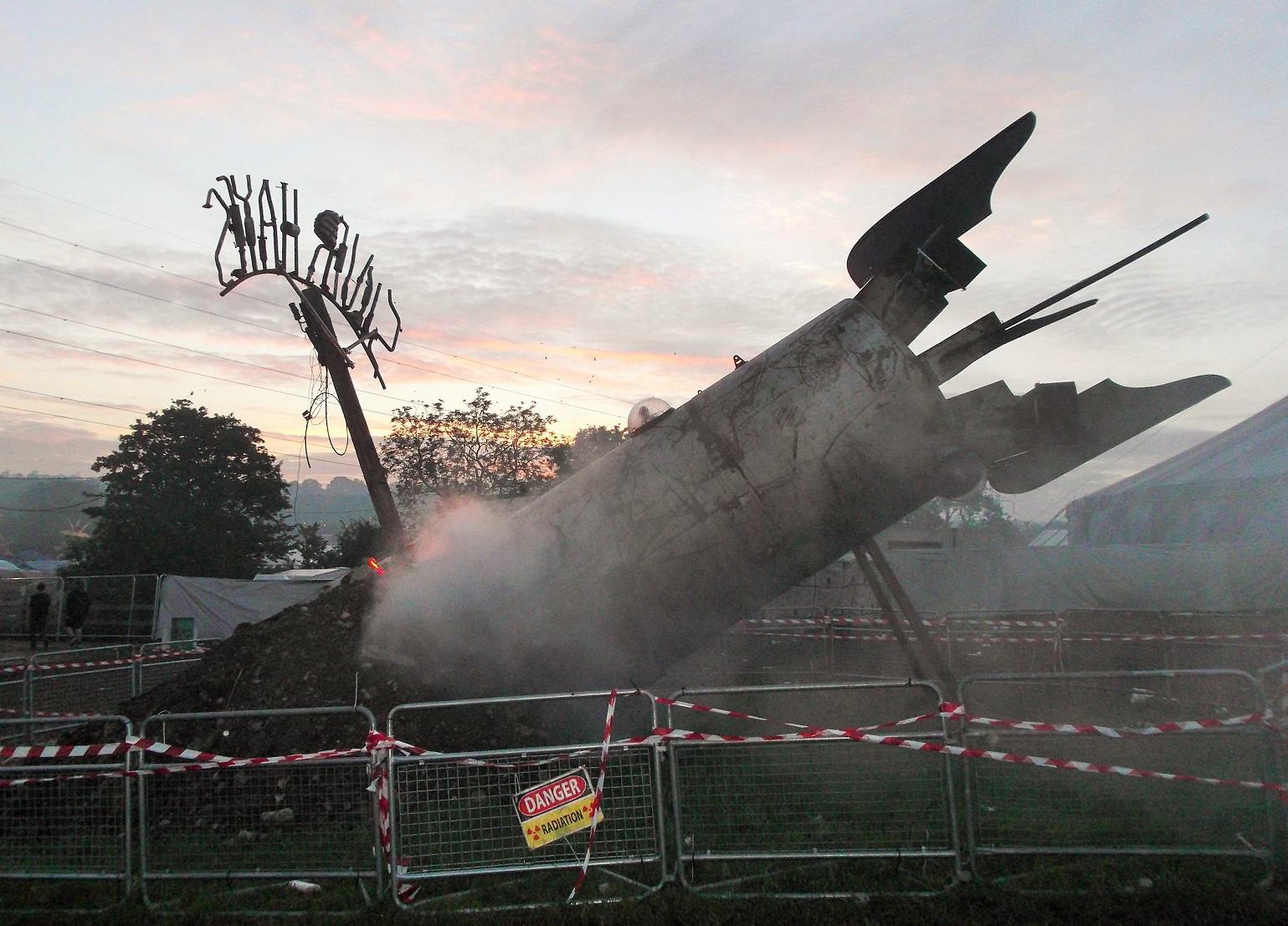
On the Pyramid James Bay is playing. It’s horrendous, the worst thing I hear all weekend, the 425th iteration of something that was miserably dull to start with. I’m sick of slagging these whiny faux-vulnerable singer-songwriters but they just keep coming, as if the very fact they’re on an acoustic guitar makes them a worthy alternative to the Top 10’s computer-generated plasticity. They’re not. Their lack of originality is, if anything, worse. He is from Hitchin, apparently. He sounds like he’s from Hitchin too. Close your eyes and think of Hitchin. That’s James Bay. Jesus.
The Alabama Shakes are next. I am lurking on the south-western side of the site as it's where Finetime will arrive soon. I want to meet him and carry everything back to the tent before Motörhead. I saw Alabama Shakes very recently and, as then, they are... OK. Their recent second album promised much, with its punk and garage flavours, and Brittany Howard is a great frontwoman. And yet the overall impression they make is one of playing safe, of plugging into retro southern soul/R&B to appeal to a conservative audience. They’re very good at it, drawing on that heritage, but I think they’re capable of busting out of the bubble with a live show that matches their most visceral recorded music.
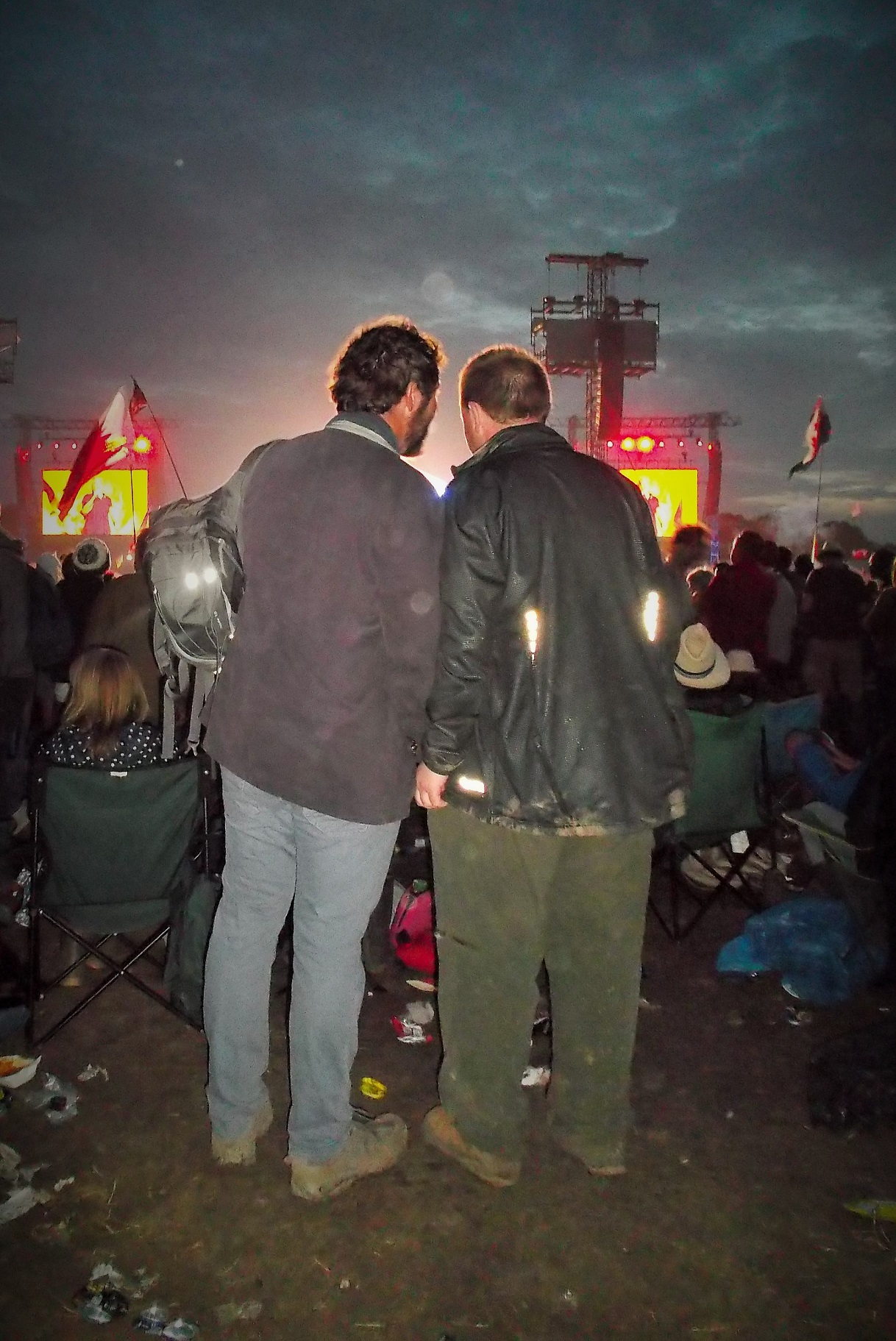
I return to my tent to have a sort out just in time to escape a rain shower. Once it passes, I walk up to Dane and Bomber’s encampment with a bottle of Maker's Mark bourbon. Bomber is holding forth to a group of lads aged around twenty. The talk is of who the mystery guest will be this evening, filling the gap left by the Foo Fighters’ absence due to injury. One of the lads says it’s the Stone Roses. Their equipment, he has it on good authority, is backstage. This would be exciting, albeit highly unlikely such a famously arrogant group would play second fiddle to Flozza & her Machine. We pass the whiskey round and Dane takes me tent-side for a Version 1.5 hoovering of Energizer Z. Suitably boosted I stride out to meet Finetime.
On the way I notice how everyone exchanges knowing smiles, like in a rave, those we’re-all-in-this-together smirks of conspiracy. I’m enjoying this until I suddenly notice myself smiling in the direction of Radio One DJ Nick Grimshaw. He doesn't see me. “Grimmy” has become totemic of a side of Glastonbury that puts many off, the celebs-in-wellies-in-the-Daily Mail aspect. He is usually seen with a fawning entourage but it’s his almost gaseous London media smugness that riles.
I find Finetime in a car park near Steanbow Farm’s expansive array of barns and modern agricultural equipment. I tell him who I’ve just seen. “Revolting,” is his only comment. He’s sat by his giant white Toyota hire car, smoking a rollie, pondering in a leisurely fashion how to repack a mass of loose odds’n’ends. Anyone who’s read my report from Glastonbury last year need only refer back to find out what happens next. History repeating. I turn to the west and black clouds are approaching. There follows debate about how fast we need to move and the short of it is we cannot/don’t move fast enough. I’m completely soaked by the ensuing torrential shower as I rush back and forth, ferrying bedding, duvets, chairs and lots more.
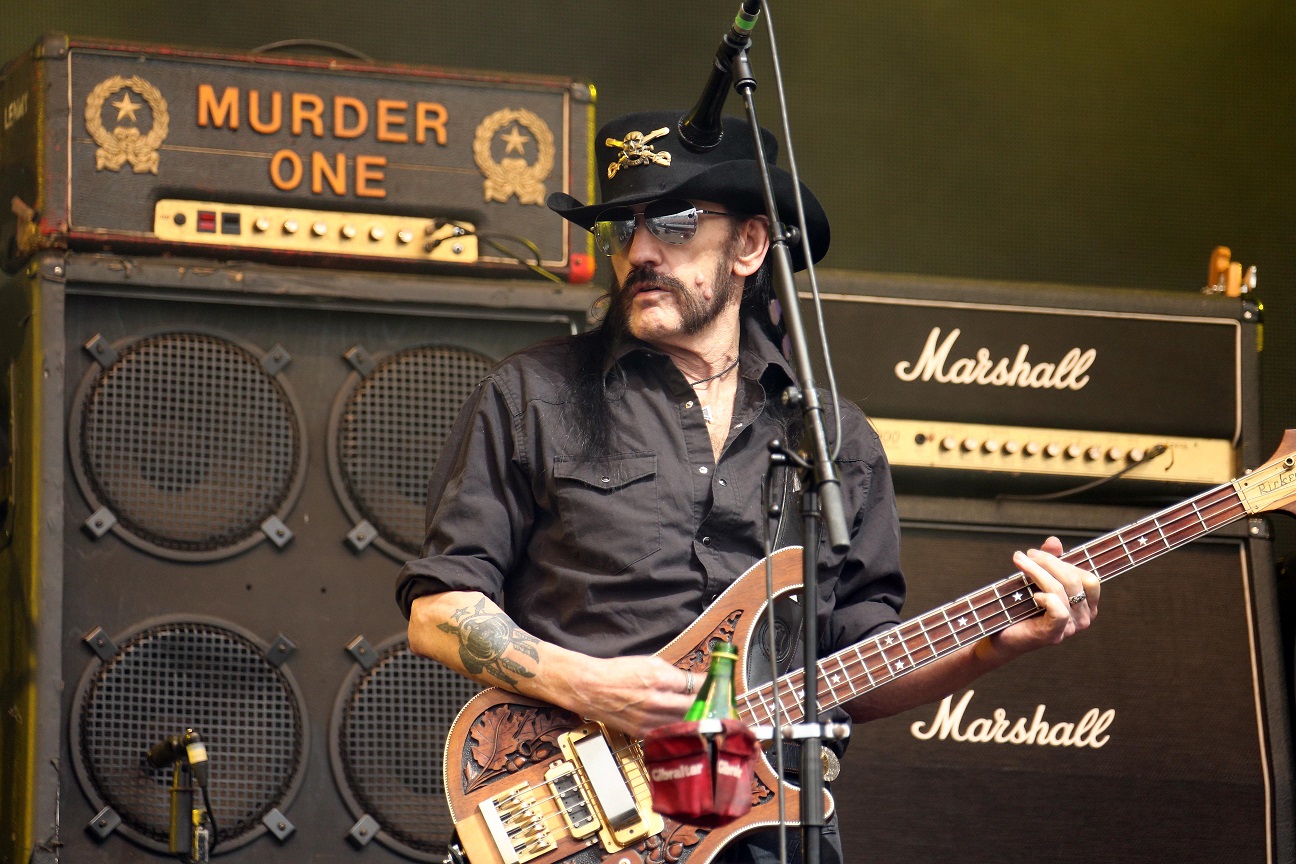 There’s no time to for moping. Motörhead (pictured above) are on in an hour. There’s work to be done. We set Finetime up swiftly, glug great swigs of Maker's Mark and Z, and head in. I’ve been hugely looking forward to this but it’s somewhat of a disappointment. Motörhead’s set is ill-judged, weighted with lesser numbers early on (and no “Bomber” or “Killed By Death”). Their manner, as if they were dossing around at a pub gig, is funny, but it lacks vitality and knock-out punchiness. By their own rampaging standards the pace is sluggish, right from the opening “We Are Motörhead”, and it’s all a bit stop-start, with awkward asides as they chivvy the crowd to shout louder. Guitarist Phil Campbell clunkily tells us to buy the new album, asking us to raise a hand if we are, and his guitar advertising a well-known cider brand is entirely crass.
There’s no time to for moping. Motörhead (pictured above) are on in an hour. There’s work to be done. We set Finetime up swiftly, glug great swigs of Maker's Mark and Z, and head in. I’ve been hugely looking forward to this but it’s somewhat of a disappointment. Motörhead’s set is ill-judged, weighted with lesser numbers early on (and no “Bomber” or “Killed By Death”). Their manner, as if they were dossing around at a pub gig, is funny, but it lacks vitality and knock-out punchiness. By their own rampaging standards the pace is sluggish, right from the opening “We Are Motörhead”, and it’s all a bit stop-start, with awkward asides as they chivvy the crowd to shout louder. Guitarist Phil Campbell clunkily tells us to buy the new album, asking us to raise a hand if we are, and his guitar advertising a well-known cider brand is entirely crass.
Most of all, though, there’s something not quite right with Lemmy. I interviewed him in 2011 and saw Motörhead play a scorching set on that same tour. He was lucid, funny, intelligent, engaging and together. Today he seems far from that man. He looks the part but something is missing. There’s a disconnected quality. Worst of all, for the final song, he starts singing “Ace of Spades”, a song he’s just finished, while the rest of the band hammer through drum tattoo classic, “Overkill”. Both are numbers he’s been playing, year in, year out, for decades. On the plus side, they attack a thrashing version of “Over the Top” and Glastonbury has its “Ace of Spades” sing-along but, as they exit, the cheer is a tribute to rock’n’roll legends rather than appreciation for a killer set. It would be a horror if Lemmy went the way of Brian Wilson, a dazed icon wheeled out for cash.

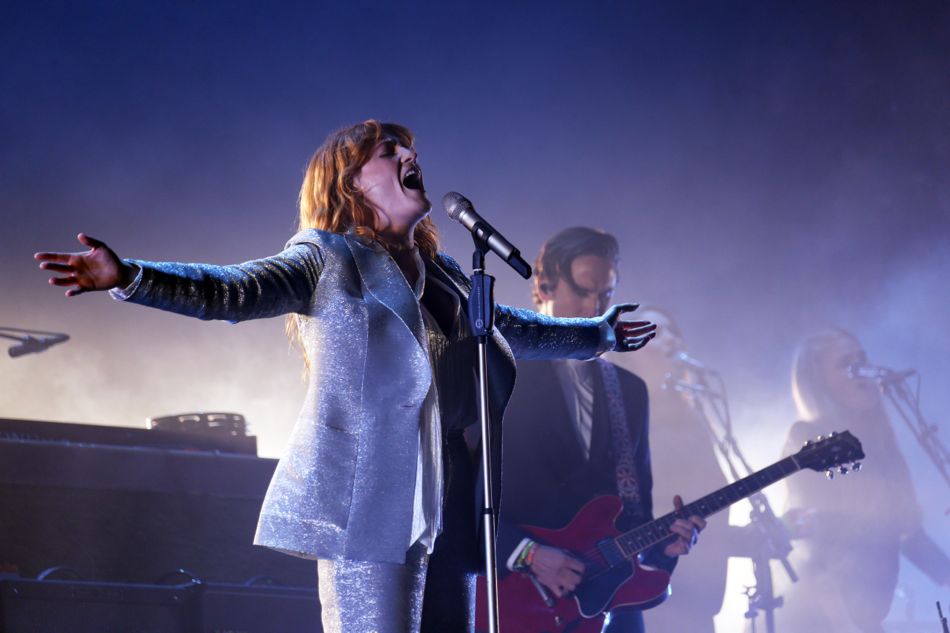 We waited out most of Florence’s set and Fojan and Leia have great grins, loving it, but song passes song, a wash of swooping vocals and uplifting, epic baroque pop-rock, including a Foo Fighters cover, and even “You Got The Love”. I remain unmoved, as does Finetime. Don Carlton insists we wait for the biggie, “Dog Days Are Over”, which we do on the way to the Cider Bus, for an easy get-out, then the three of us bolt for the far-flung fields, the South-Eastern Corner, to find our friends Mr Massive Cock (pseudonym unwisely requested while “refreshed” in the wee hours of Sunday night) and his girlfriend Candy.
We waited out most of Florence’s set and Fojan and Leia have great grins, loving it, but song passes song, a wash of swooping vocals and uplifting, epic baroque pop-rock, including a Foo Fighters cover, and even “You Got The Love”. I remain unmoved, as does Finetime. Don Carlton insists we wait for the biggie, “Dog Days Are Over”, which we do on the way to the Cider Bus, for an easy get-out, then the three of us bolt for the far-flung fields, the South-Eastern Corner, to find our friends Mr Massive Cock (pseudonym unwisely requested while “refreshed” in the wee hours of Sunday night) and his girlfriend Candy.
Don is starting to show signs of Psychic Absence Syndrome, a common Glastonbury issue, where the spirit and body are willing but the mind is weak. In practice this means endlessly traversing the site, a void behind the eyes and conversational ability reduced to a vapid schizoid grin. We find Mr Massive Cock and Candy in The Copperdollar, a blues bar populated by black and white zombies with rough rhythm & blues playing. It’s a great joint and I suck back JD & cokes, feeling really good. Don takes to the dancefloor, voodoo skeletal performers join him. When we leave, we have to lead him – then go back for his lost backpack – then lead him away again. He has not eaten enough.
Next is The Cave, another venue on The Common, where we spend aeons dancing to Polish DJ Radikal Guru whose amalgam of rock-steady reggae rhythms and dubstep works a treat, as does the Channel One Sound System that follows him. It’s the kind of reggae that keeps you dancing rather than weighing you down in a skunk haze. The wob-wob, the Z, the whiskey and the scrumpy all blend to full effect.
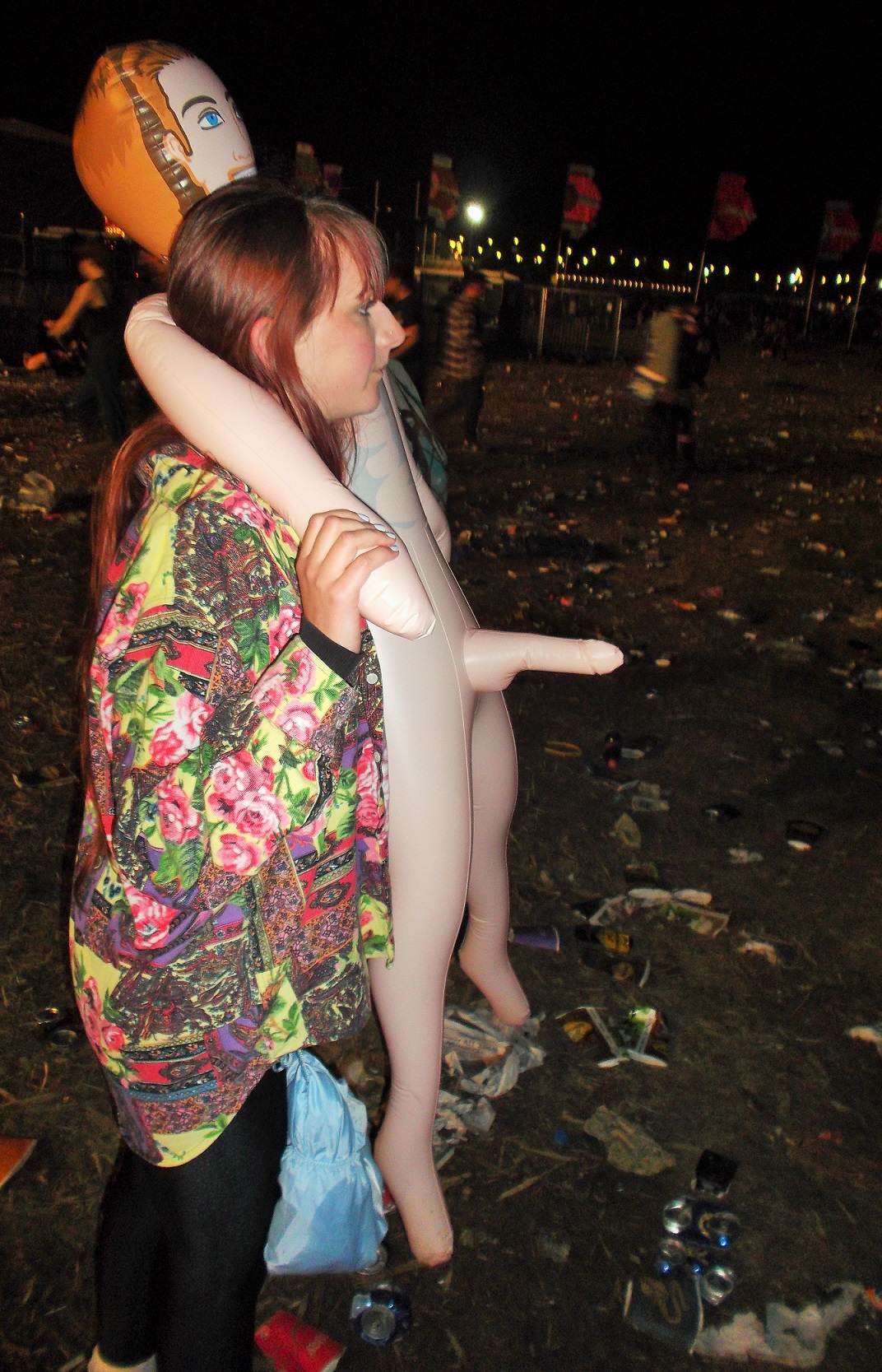
Overleaf: read Saturday and Sunday
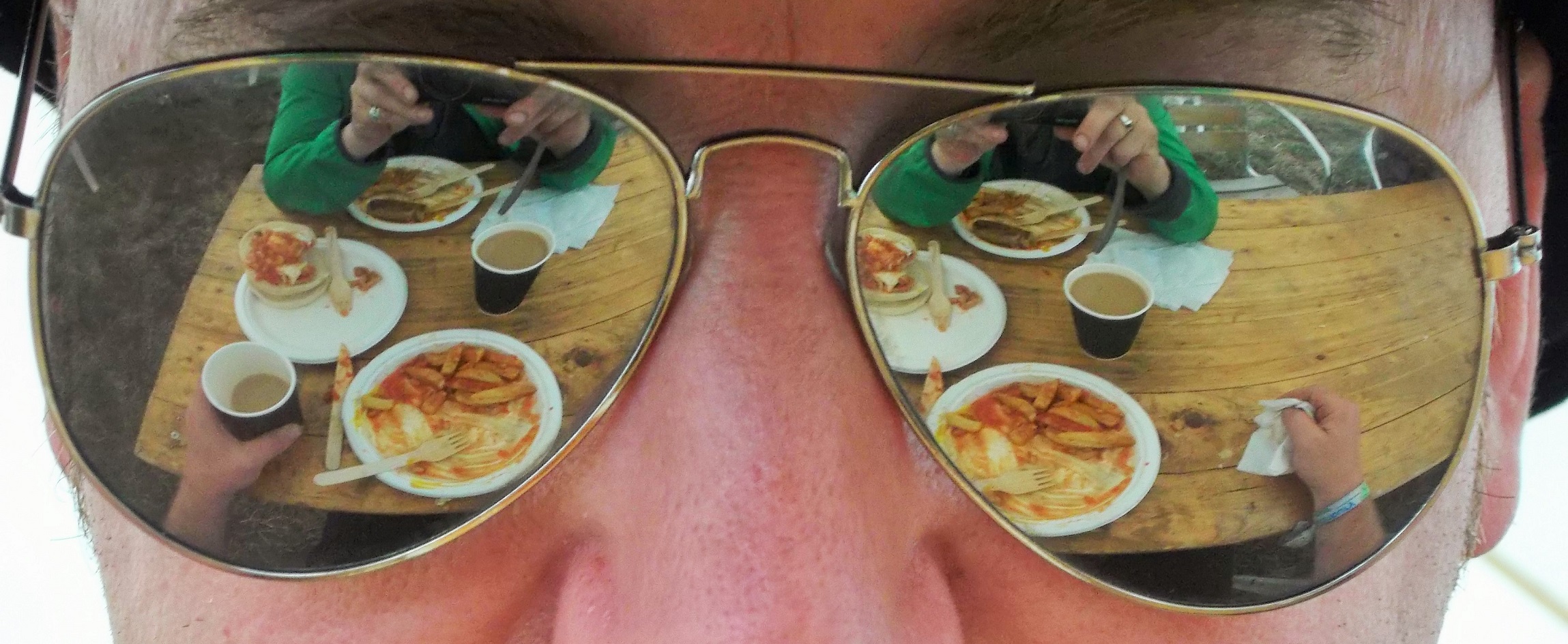
After a full English breakfast while chatting to a female steward who’s been coming here since 1979, Finetime and I go to the Theatre and Circus Fields. I suck cold lager tops in glorious sunshine while he takes photographs of the nutty proceedings. A band in bowler hats plays famous ska songs on a low stage nearby, strolling players clad in yellow offer lessons in happiness, others sell snake oils seedily from a car, most quite simply look utterly bizarre, like the two Mervyn Peake-esque porters hunched beneath piles of suitcases. Time slips by in an idyll of sun-laced surrealist mind-candy, concluded by a trip to the grubby Bramble FM Roadshow caravan, with its Take Hart Cinzano Activity Table and Fred Dibnah Memorial Chimney, and local radio-style presenters Les and Maureen dancing to Gary Glitter and Chas’n’Dave. They make me laugh until it hurts.
We race over to the Pyramid where Burt Bacharach is playing. I have been espousing the opinion that he will be 2015’s true Golden Afternoon Oldie as his tunes are class whereas Lionel Richie… well, more on this come Sunday. There’s a stall on the way selling fish finger sandwiches at a fiver a hit. Finetime and I take one each. I always put a few quid aside for Glastonbury in the preceding weeks as I don’t want to think too much about money here. It would be like going to Reykjavik and moaning every time you bought one of their £10 pints. If you’re going to spend too much on something over-priced on purpose you might as well enjoy it rather than resent it. Genius, though, fish finger sandwiches – and they were flying out. Went down a treat too, all crunchy and lathered in ketchup (or tartare sauce if you’re classy like Finetime).
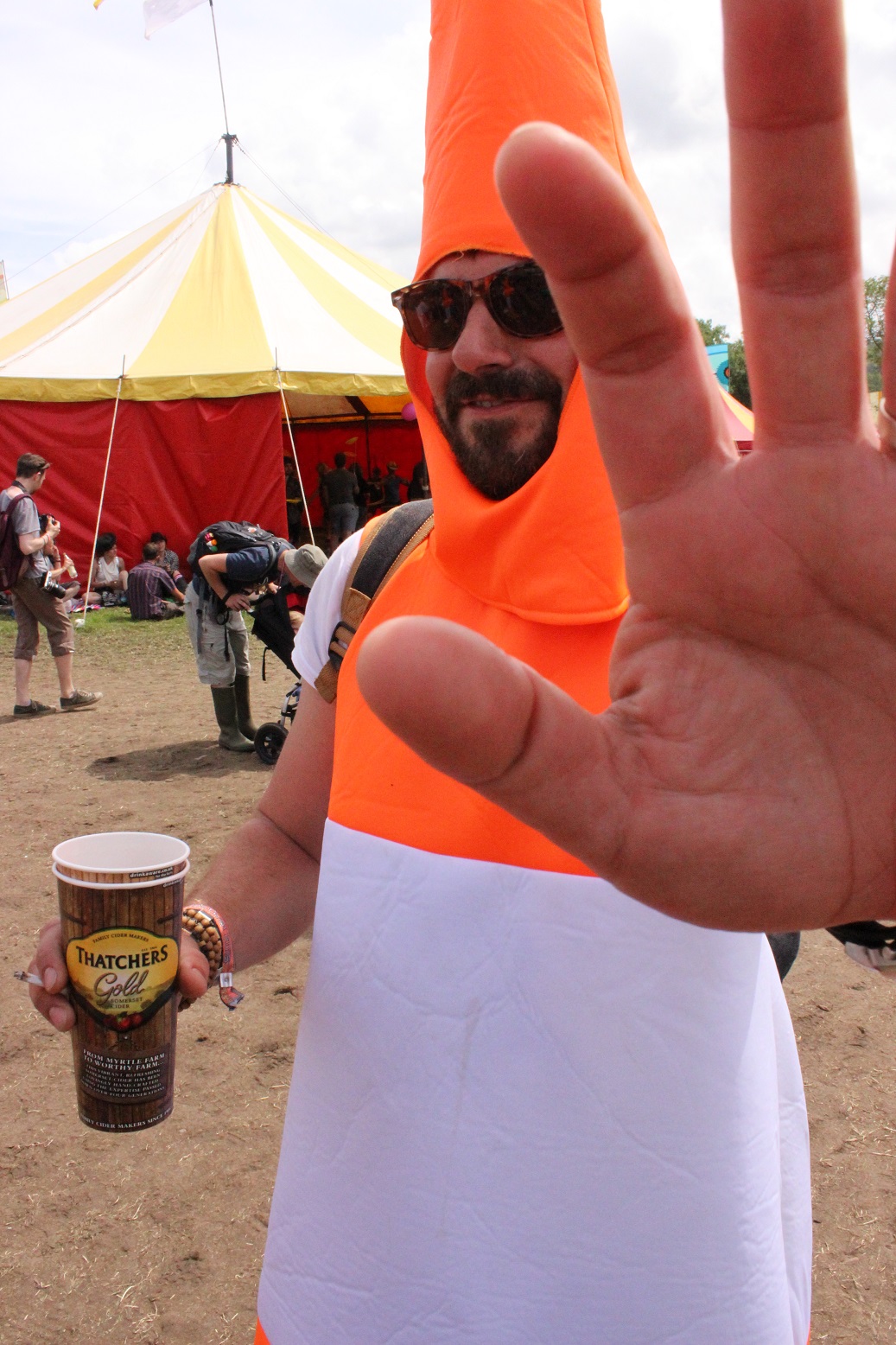
I part ways with Dane and Bomber, then head back to the tent. I come across Fojan and Leia on the journey. Their Friday night went dark when a woman fell down in front of them in the muddy passage leading backstage. It became clear fast she’d broken her leg, bone sticking out and all. Time was spent waiting in the muddy dark for the emergency services, keeping her from seeing the grisly mess. After that, unsurprisingly, their buzz was somewhat dissipated.

Don tells us he was in the open air urinals and a bloke said to him, “Hey, mate, check this out,” and brandished a mobile phone containing a selfie taken with Nick Grimshaw. “Grimmy,” we groan. “Revolting,” says Finetime. I read out bits of the programme. The Tipi Field looks a riot. Among much else it contains a Moon Lodge where women can “share their visions, honour their menstrual time, and celebrate their fertility and the cycles of nature”. The Spiritual Readings tipi also looks intriguing: “Sally Pullinger, full trance medium from Glastonbury, will offer the opportunity to listen and speak to spirit guide Chung Fu and other ascended beings of light.” Finetime, Don and I determine to keep an eye open for ascending beings of light. “They must be like gods,” Don says with wonder, raising a Swiss Army Knife screwdriver of Energizer Z to his nose and honking loudly. We nod in agreement, then do the same.
 Now we’re cooking. That’s how to prepare for a night out. We set out for the Family Stone and George Clinton’s assembled armada of aliases at West Holts. This takes us across the very top of the Pyramid field just as Pharrell’s set is reaching its climax. Waving my ruinous-looking scrumpy about I cannot help but run into the crowd and dance to Snoop Dogg’s “Drop It Like It’s Hot”, Daft Punk’s “Lose Yourself to Dance” and even the horrid Robin Thicke song “Blurred Lines”. I have briefly become a one man hen party. I lose my bet that Pharrell (pictured above left) will be wearing a giant hat. Apparently he gave them up ages ago. He’s wearing a little sailor’s cap and looking about 12. He finishes with one of the best songs of the last decade, a song that Nile Rodgers apparently wasn’t allowed to play at Glastonbury 2013, Daft Punk’s 24-carat pop floorfiller, “Get Lucky”. Pharrell goes onto “Happy” but it can’t compete so we move on.
Now we’re cooking. That’s how to prepare for a night out. We set out for the Family Stone and George Clinton’s assembled armada of aliases at West Holts. This takes us across the very top of the Pyramid field just as Pharrell’s set is reaching its climax. Waving my ruinous-looking scrumpy about I cannot help but run into the crowd and dance to Snoop Dogg’s “Drop It Like It’s Hot”, Daft Punk’s “Lose Yourself to Dance” and even the horrid Robin Thicke song “Blurred Lines”. I have briefly become a one man hen party. I lose my bet that Pharrell (pictured above left) will be wearing a giant hat. Apparently he gave them up ages ago. He’s wearing a little sailor’s cap and looking about 12. He finishes with one of the best songs of the last decade, a song that Nile Rodgers apparently wasn’t allowed to play at Glastonbury 2013, Daft Punk’s 24-carat pop floorfiller, “Get Lucky”. Pharrell goes onto “Happy” but it can’t compete so we move on.
West Holts is filling up. Finetime’s friend Sarla is there on a crutch. Her broken ankle, healing prior to Glastonbury, has been exacerbated by wandering endlessly. Now she must chose a base and stick to it. This doesn’t seem to bother her too much. She’s on ecstatic anaesthetic with irises retreating and a half-moon grin. Fojan is there too but her high is edgier. Leia has had to go home due to a family emergency. On top of the broken leg episode and the pole-less tent, this negative stuff is starting to permeate Fojan’s thick skin.
The Family Stone – minus fried Sly, of course – walk on stage and start in on the loveliest, earliest crossover psychedelic pop-funk – “Dance to the Music”, “Everyday People”. It all has a likeable retro sweetness but I feel an urge to check out Kanye West. He is starting now and, after all the talk about him being an arrogant bell-end, I want to see the nay-sayers proved spectacularly wrong, just like with Jay-Z in 2008. No-one wants to accompany me. They’re all enjoying the Family Stone too much and are entirely convinced Kanye will be a rubbish.
Thus I set out alone. At the Pyramid Kanye West is running about alone under a ceiling of spotlights, spitting lyrics forcefully into the mic. He looks like he’s in a boxed catwalk of light. “Great way to start,” I think to myself. The set-up has tight style. Songs pass by, half an hour passes, nothing changes. He's still just running about chatting, making no effort to connect, no effort to deliver anything except pumped up narcissism. Even “Black Skinhead”, my glam stomp favourite, fails to thrill, although it’s entertaining when Kanye decides to restart it due to a stage invader (a minor comedian called Lee Nelson, it later turns out). The single word for this set is “joyless”. He’s not sharing anything with anyone. It’s all about him. I ask a couple of 20-year-olds jigging nearby, “Is this joyless or am I just old?”
“No,” they reply in unison, “Joyless.”
“Perhaps it looks great on telly,” I suggest.
“My mate just texted me,” says one, “He says it looks shit-boring on telly. Why doesn’t he do something?”
Why indeed. The crowd is willing Kanye West to be great, to give them the chance to party with him. He certainly doesn’t want to do that and doesn’t even appear very interested in entertaining them either. He's blowing it. Still, there was apparently a flag in the crowd showing an image from Kim Kardashian’s long-ago sex tape. This provides a neat conversational “in” for people with no lives whatsoever, allowing them to make a tabloid-led connect with Glastonbury and opinionate for days afterwards. So much for that.
The last thing I hear as I walk away are the lyrics “pussy so deep I could’ve drowned twice”. Then he’s out of earshot. At the tiny bandstand in the market next door a Latino band called Baila La Cumbia are cutting a rug before a small crowd of enthused dancers. They are, genuinely, far more enjoyable than Kanye West.
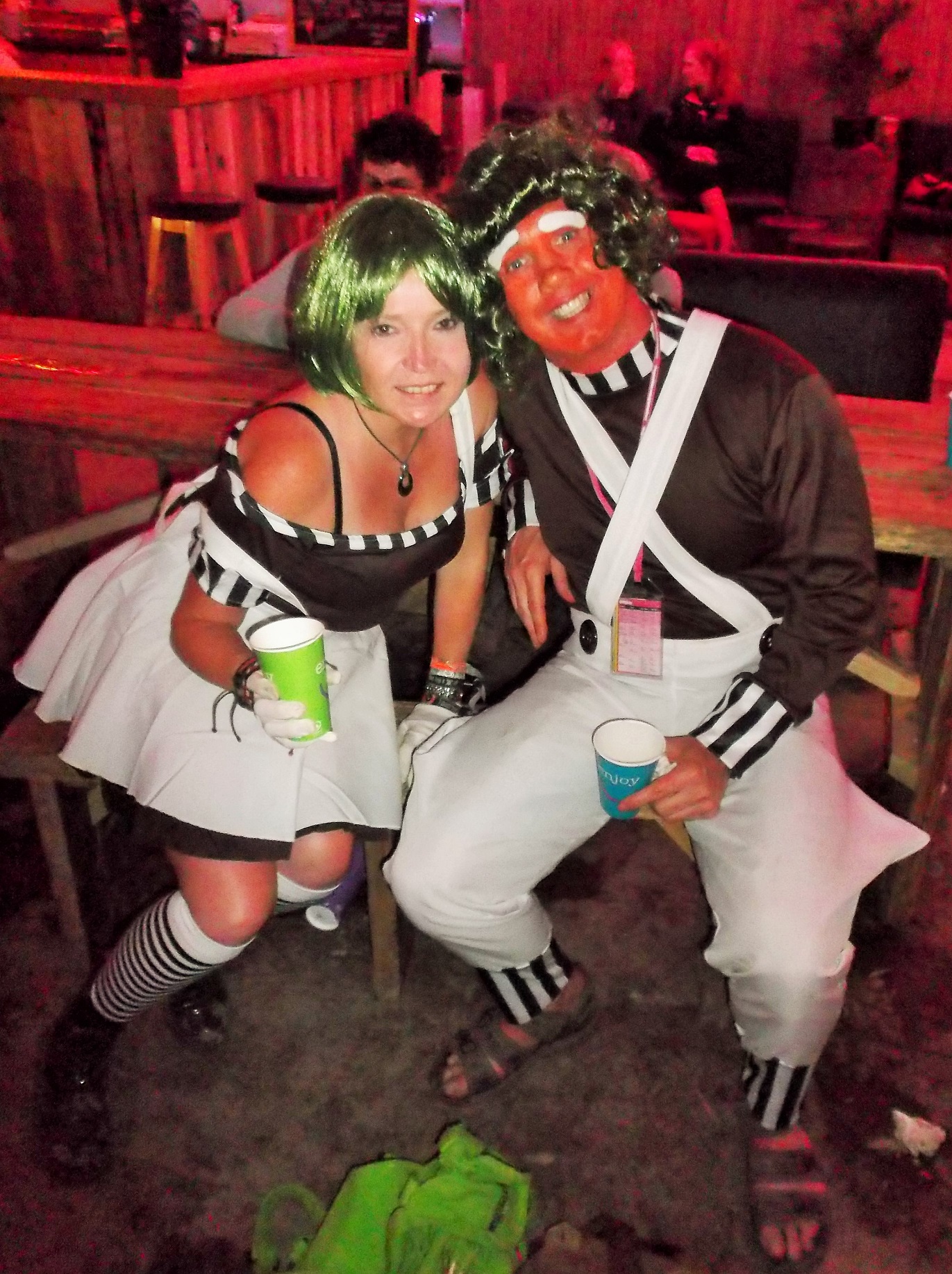
The four of us then spend an inordinate amount of time hanging out with friends Pestilence and Lady P at the Cornish Arms, a proper ale pub but with DJs and a much higher degree of frenetic nightworld looning. It’s a time of catching up and intensity and truth and the minutes on the clock being suddenly possessed by the second hand. Afterwards we clamber up to the Park and in the Stonebridge Bar to dance for hours to Toddla T and his guests, spinning everything from speed garage to dub to hardcore. Dawn comes and goes and, eventually, so do frazzled we.
Sunday 28th June
The weather here is much as it has been for some years, which is to say sunshine with showers. At Glastonbury 2015 the showers come on Friday afternoon and Sunday morning. The weather forecasts predicted rain all Sunday so it was a blessed relief when the grey clouds give up by lunch and the sun quickly dries the mud down.
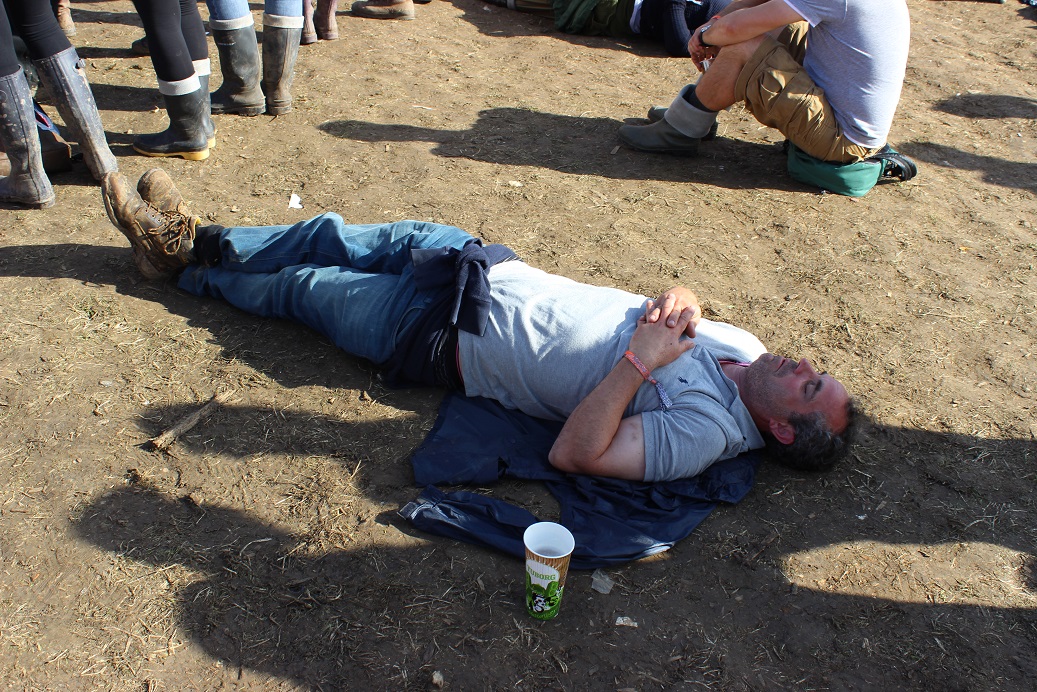
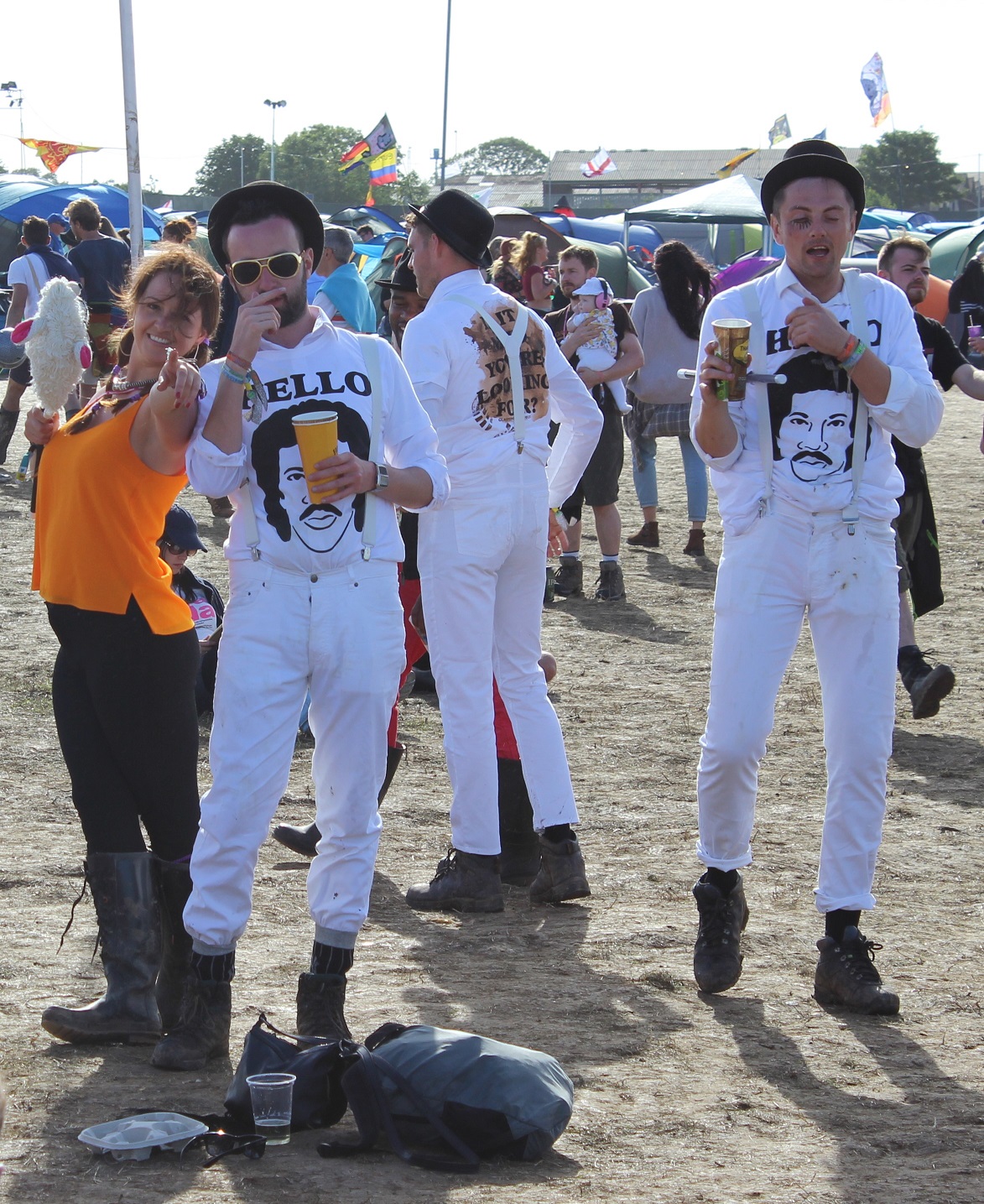
Swigging a couple of quick cider brandies from the bus, I then drop my mirrored aviators irretrievably into the guts of a long-drop toilet. Happily I have a blue rhinestoned Bullhide cowboy hat to shade my eyes from the sun. The three of us push through a tight crowd, the biggest of the weekend, breaking through the dense outskirt layer, which is always the hardest part, and finding space within easy view of the stage. Lionel’s already onto two bona fide classics “Easy” and the 1977 funk behemoth “Brick House”. The atmosphere is tangible. By the time he’s midway through his set 100,000 people, right up the hill to the Row Mead and Big Ground meadows, are roaring along with everything. I too am swept up. Richie is clearly having the gig of his life. I imagine he usually plays Vegas-type supper crowds across the States. Now he’s suddenly at the core of intense power that Glastonbury can muster. It’s as preposterous as it is amazing. He stops at one point, flabbergasted, and repeatedly shakes his head and says, “Glastonbury, what the hell is going on?”, as he gathers it all into himself. The effect of the final run of “Say You, Say Me”, “Dancing on the Ceiling”, “Hello” and “All Night Long (All Night)” pushes it to the limit. Dane, Bomber and I exchange silly grins, knowing it’s a moment as Lionel sings “Glastonbury, I love you,” during “Hello”.
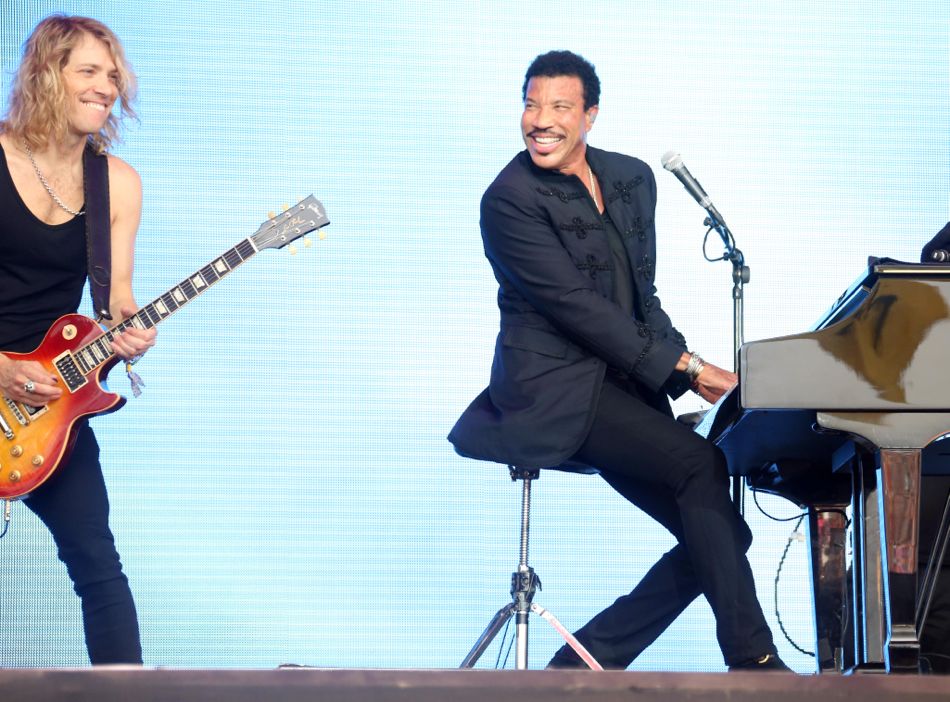 Of course, afterwards, especially back home after the festival, it’s all a bit silly and embarrassing. I thought I’d be at Django Django, not Lionel. My opinion has not changed a jot. “Hello” is one of the most annoying songs and Lionel Richie, charming though he is, will never be on my playlist. But, boy, this sunny Sunday afternoon, something happened and he was at the heart of it. He overreached himself in the end with “We Are the World”, which is too American schmaltzy even for Glastonbury’s good will. Dane, Bomber and I are a huddle of hugs then they’re off to see Eric Bibb at the Acoustic Tent. I don’t see them again. But what a way to go out.
Of course, afterwards, especially back home after the festival, it’s all a bit silly and embarrassing. I thought I’d be at Django Django, not Lionel. My opinion has not changed a jot. “Hello” is one of the most annoying songs and Lionel Richie, charming though he is, will never be on my playlist. But, boy, this sunny Sunday afternoon, something happened and he was at the heart of it. He overreached himself in the end with “We Are the World”, which is too American schmaltzy even for Glastonbury’s good will. Dane, Bomber and I are a huddle of hugs then they’re off to see Eric Bibb at the Acoustic Tent. I don’t see them again. But what a way to go out.
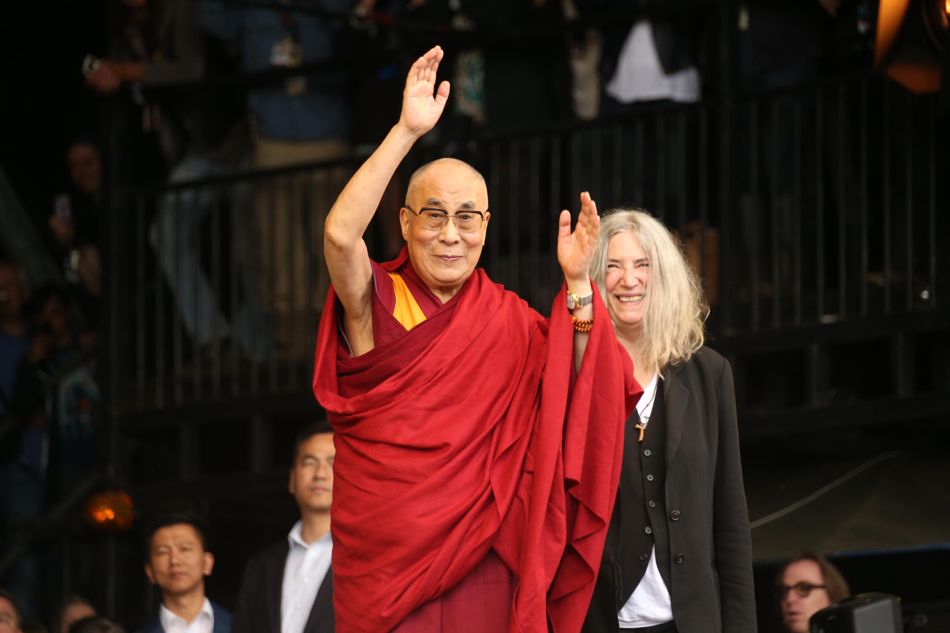 I find Finetime having a drink with Don, both giggling about their new Lionel adaptation, “Say Poo, Say Wee”. Wildean wit all the way on a Glastonbury Sunday. Fojan is with them but she now has Psychic Absence Syndrome. Her voice has disappeared to a croak. Her eyes are dazed. She’s worried about Leia. She saw the Dalai Lama this morning. That’s all I can squeeze out of her. Don Carlton saw the Dalai Lama too, when he came onstage with Patti Smith (pictured above right). It sounds an amazing set. She fell over at one point and announced, “I fell on my ass at Glastonbury, but I don't care 'cause I'm a fucking animal!” Kupe is also with us, rolling balls of MDust into Rizla papers and offering them about for swallowing. Everyone says, “Let’s eat first.” We sit at the back of the Other Stage and watch a chunk of Baltimore synth-rockers Future Islands. Don and I argue about whether the growling voice of their stocky, sweaty Jack Black-alike lead singer, Samuel T Herring is refreshing or jarringly annoying. I’ll have the last word right here – it’s a refreshing change from all the falsetto voice-breaking whingers out there. Their melodramatic music has its moments too, notably “Seasons (Waiting on You)”, the one that went globally viral last year after their appearance on David Letterman.
I find Finetime having a drink with Don, both giggling about their new Lionel adaptation, “Say Poo, Say Wee”. Wildean wit all the way on a Glastonbury Sunday. Fojan is with them but she now has Psychic Absence Syndrome. Her voice has disappeared to a croak. Her eyes are dazed. She’s worried about Leia. She saw the Dalai Lama this morning. That’s all I can squeeze out of her. Don Carlton saw the Dalai Lama too, when he came onstage with Patti Smith (pictured above right). It sounds an amazing set. She fell over at one point and announced, “I fell on my ass at Glastonbury, but I don't care 'cause I'm a fucking animal!” Kupe is also with us, rolling balls of MDust into Rizla papers and offering them about for swallowing. Everyone says, “Let’s eat first.” We sit at the back of the Other Stage and watch a chunk of Baltimore synth-rockers Future Islands. Don and I argue about whether the growling voice of their stocky, sweaty Jack Black-alike lead singer, Samuel T Herring is refreshing or jarringly annoying. I’ll have the last word right here – it’s a refreshing change from all the falsetto voice-breaking whingers out there. Their melodramatic music has its moments too, notably “Seasons (Waiting on You)”, the one that went globally viral last year after their appearance on David Letterman.
Finetime buys me new shades. I spill his coffee in return, I agree to buy a new one but the coffee shop turns my mood dark. Coffee smells like work. It’s depressing stuff. Instead we all sample another stimulant, Formulation R, which improves everyone’s outlook, except Fojan’s. She wisely turns it down. After all, the only cure for Psychic Absence Syndrome is sleep. Food and sleep are the advanced hedonists’ greatest friends. Which is why I also eat a large steak and kidney pie with mashed potato and mushy peas. We walk back to the tents and Fojan tucks up on her inflatable mattress. It’s the last I see of her.
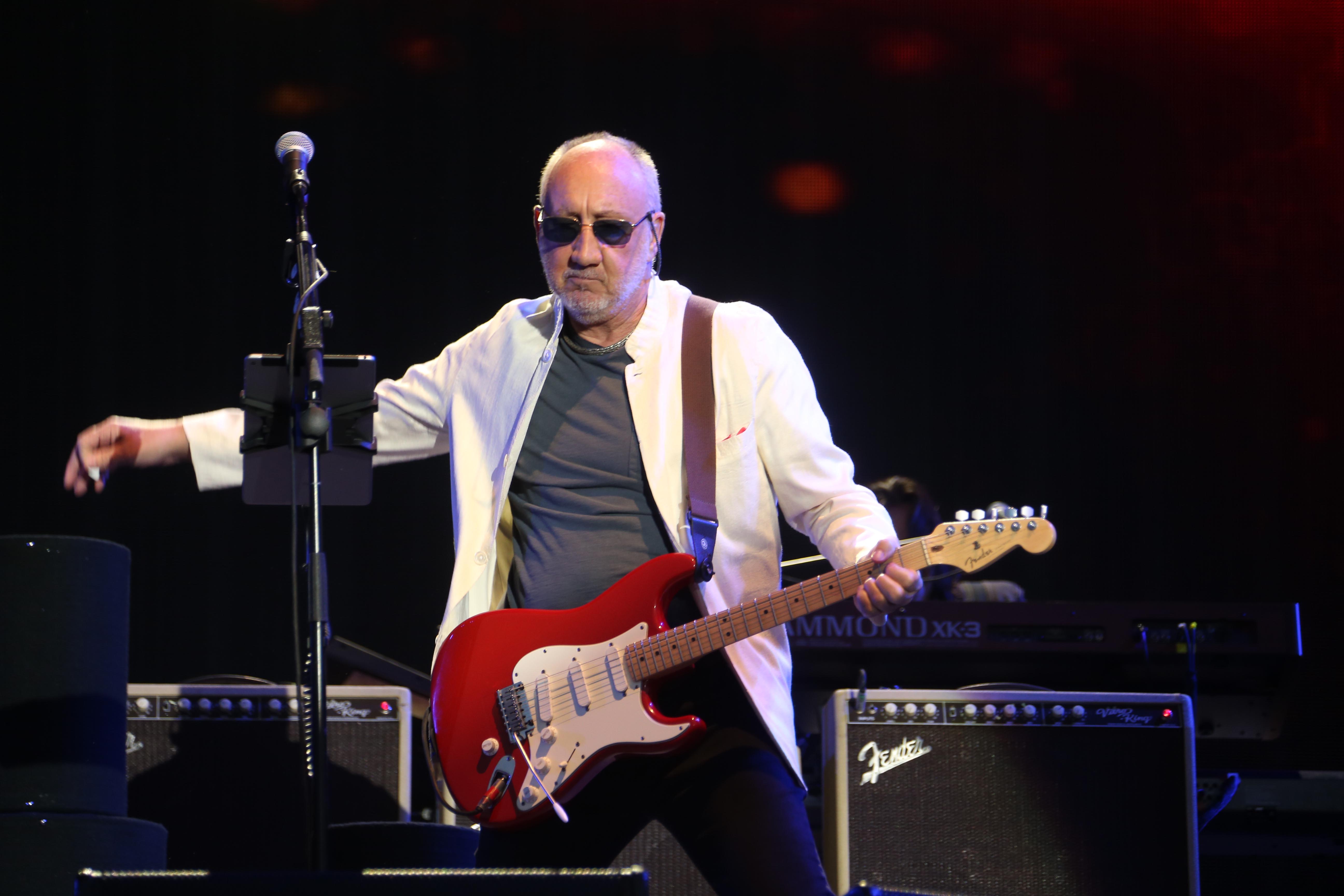 Kupe, Don, Finetime and I soon head back out for The Who (pictured above). They played here in the windswept mire of 2007 so it’s good to have them back in more temperate times. Mr Massive Cock and Candy join us. It’s a crowd-pleasing Sunday night greatest hits set and, with my head nicely billowin', and my retinas fizzing gently, I clamber into Pete Townsend’s windmilling riffs as the sun sets for the final time over Glastonbury 2015. That said, at first I am very aware that Kupe and Don are not quite so convinced, which makes my groove a little uptight (maaan). They leave after “My Generation” for the Chemical Brothers and I immediately loosen up and join Finetime, Mr Massive Cock and Candy leaping and shaking about. Zak Starkey’s on drums, Roger Daltrey makes a pointed remark about rock stars aimed at Kanye West's messianic claims the night before, and Peter Townsend fusses too much about his guitar sound before finally settling to enjoy things. “I Can See For Miles”, “The Kids Are klright”, “Behind Blue Eyes”, “Pinball Wizard”, they keep 'em comin' as images of Who iconograophy – Keith Moon, John Entwhistle and plenty of mods – liven up the visual show. They end with “Won’t Get Fooled Again”, enjoyably barn-storming.
Kupe, Don, Finetime and I soon head back out for The Who (pictured above). They played here in the windswept mire of 2007 so it’s good to have them back in more temperate times. Mr Massive Cock and Candy join us. It’s a crowd-pleasing Sunday night greatest hits set and, with my head nicely billowin', and my retinas fizzing gently, I clamber into Pete Townsend’s windmilling riffs as the sun sets for the final time over Glastonbury 2015. That said, at first I am very aware that Kupe and Don are not quite so convinced, which makes my groove a little uptight (maaan). They leave after “My Generation” for the Chemical Brothers and I immediately loosen up and join Finetime, Mr Massive Cock and Candy leaping and shaking about. Zak Starkey’s on drums, Roger Daltrey makes a pointed remark about rock stars aimed at Kanye West's messianic claims the night before, and Peter Townsend fusses too much about his guitar sound before finally settling to enjoy things. “I Can See For Miles”, “The Kids Are klright”, “Behind Blue Eyes”, “Pinball Wizard”, they keep 'em comin' as images of Who iconograophy – Keith Moon, John Entwhistle and plenty of mods – liven up the visual show. They end with “Won’t Get Fooled Again”, enjoyably barn-storming.
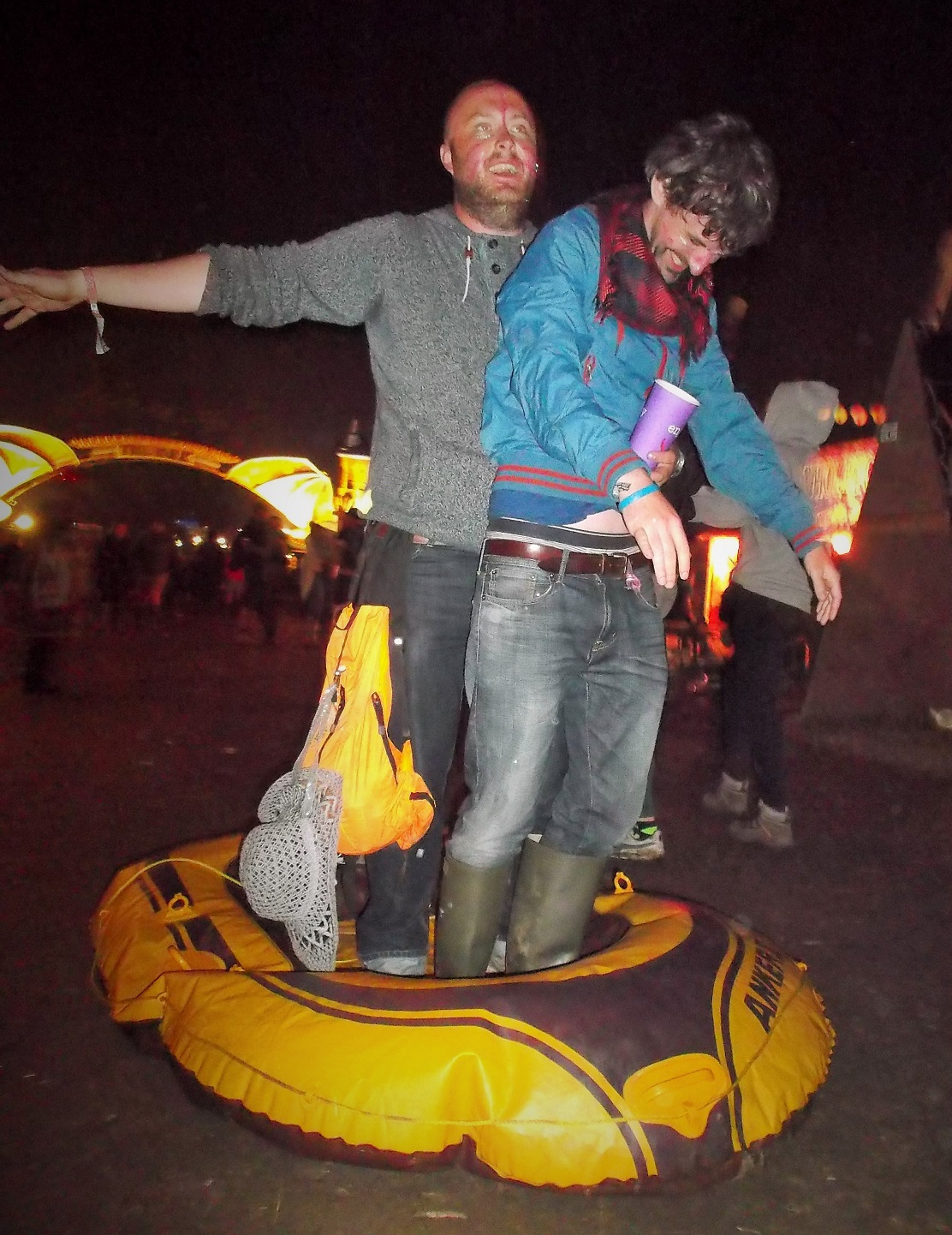
“Don,” I say, “Do not, whatever you do, pull out anything you shouldn’t at this point.”
Glastonbury security are usually decent. They stop all manner of wrongness but they adhere to the central principle of the place, Hakim Bey's idea of the “temporary autonomous zone”. Their job is to make sure no harm comes to people. 7144 is a different beast. After a while he vanishes, then reappears with a whole team in his wake, carrying some poor bastard out of the crowd. He has found a victim. We all shiver at his ugliness.
 From there it really is the last push to Moscow, farewell to Mr Massive Cock and Candy, dancing to DJ Die in the Stonebridge bar, wandering, led by Finetime, ending up at the Rum Shack on the Common, shuffling to DJs Jinx in Dub and Lazlo Legezer. In sleepless fields we have found our other England, grown completely lost in it, the outside world forgotten, everywhere bodies still moving, dawn rising, ascended light beings, all of us. One rave to rule them all – One rave to find them – One rave to bring them all – And in the madness bind them.
From there it really is the last push to Moscow, farewell to Mr Massive Cock and Candy, dancing to DJ Die in the Stonebridge bar, wandering, led by Finetime, ending up at the Rum Shack on the Common, shuffling to DJs Jinx in Dub and Lazlo Legezer. In sleepless fields we have found our other England, grown completely lost in it, the outside world forgotten, everywhere bodies still moving, dawn rising, ascended light beings, all of us. One rave to rule them all – One rave to find them – One rave to bring them all – And in the madness bind them.
And then it stops as suddenly as it started.

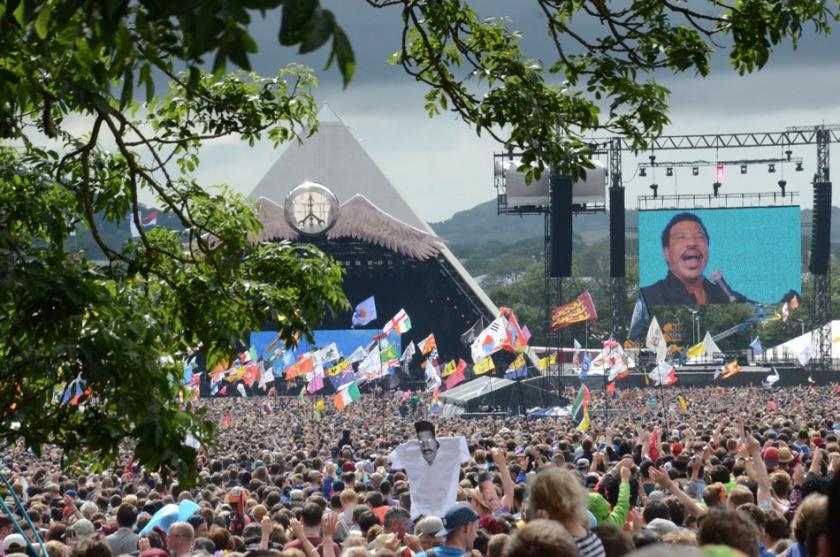













Add comment